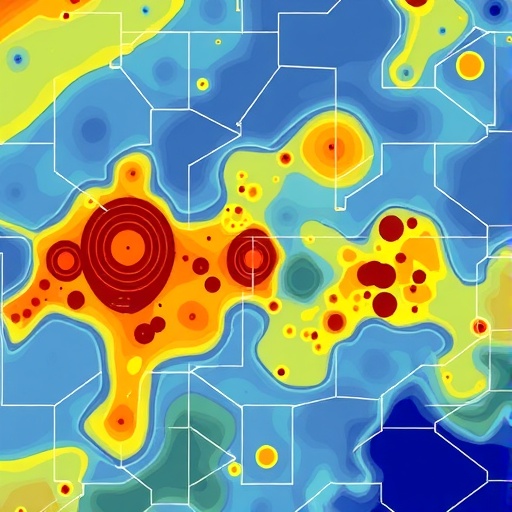In a groundbreaking study published in Nature Resources Research, researchers Y. Feng, Y. Wang, and C. Wang, along with their team, delve into the realm of automated geochemical anomaly detection. The study, designed to advance the methods of identifying geochemical anomalies, utilizes innovative techniques such as Self-Organizing Maps (SOM) and metric learning, potentially transforming mineral exploration and geochemical analysis. This paper opens avenues toward more efficient and effective methods to investigate geological formations, enhancing the ability to locate critical resources necessary for modern industries.
The need for automated detection methods has become increasingly pressing as the complexity and vastness of geochemical data surge. Traditional methods of detecting geochemical anomalies often rely heavily on human interpretation and manual analysis, leading to potential oversights and inaccuracies. By employing advanced computational techniques, Feng and colleagues propose a framework that significantly reduces the cognitive load on geologists and increases the accuracy of anomaly detection. This systematic approach harnesses the power of machine learning to identify patterns that would be difficult or impossible to discern using conventional methods.
Self-Organizing Maps, a type of artificial neural network, serve as the backbone of the proposed framework. SOMs cluster high-dimensional data into a lower-dimensional representation, making it easier to visualize relationships among various geochemical elements. By mapping geochemical data onto two-dimensional grids, the researchers can uncover underlying structures and groupings that may indicate significant mineral deposits. The ability to visualize complex datasets in this manner is a game changer, allowing geoscientists to draw insights swiftly and accurately.
Metric learning further enhances the functionality of this automated detection system. By optimizing distance metrics, this technique allows the system to learn the most relevant features of the geochemical data, differentiating between normal and anomalous observations more effectively. This learning process is crucial in training the system to recognize subtle distinctions, enabling it to flag important anomalies that could otherwise go unnoticed. The integration of SOM with metric learning effectively amplifies the capabilities of automated anomaly detection.
Moreover, the research emphasizes the importance of large datasets in training these machine learning models effectively. Global datasets, combined with regional geological and geochemical information, provide a solid foundation for the SOM framework. By applying this data-driven approach, the study demonstrates a significant improvement in detecting spatial relations and patterns associated with geochemical anomalies. The focus on robust dataset utilization underscores the role of comprehensive data collection in improving the effectiveness of automated systems.
In their methodology, Feng and co-authors conducted extensive validation of the proposed framework. By testing its functionality on known geological datasets, the researchers were able to refine the detection accuracy and demonstrate reliability. The validation phase is crucial in establishing the credibility of their approach — it showcases not just the theoretical aspects of their work but solid empirical evidence supporting their claims. The outcomes indicate that their automated system not only identifies anomalies with precision but also reproducibly does so across different datasets.
The implications of this research extend beyond mere anomaly detection; they touch upon environmental monitoring, resource management, and sustainable exploration practices. By facilitating the efficient identification of mineral deposits, this study contributes to responsible resource extraction, minimizing environmental degradation associated with traditional exploration practices. The ability to swiftly pinpoint areas of interest reduces unnecessary drilling and exploration activities, leading to more strategic and environmentally conscious methods of resource acquisition.
Additionally, the exploration of geochemical anomalies has implications for environmental science, particularly in identifying pollution sources and assessing soil health. In various contexts, understanding anomalies in geochemical data can provide insights into human-induced changes in the environment. The automated system developed by Feng et al. holds the promise of aiding in these efforts, allowing for timely responses to environmental challenges and enhancing our understanding of anthropogenic impacts on natural resources.
Feng and colleagues also discuss the potential for their methodology to be adapted for various geochemical applications across different fields, including agriculture, urban planning, and public health. The versatility of their system suggests that with slight modifications and additional training, the model could serve other critical functions, emphasizing the broad relevance of their findings in interdisciplinary research. Such adaptability reinforces the significance of integrating advanced computational techniques into geochemistry and earth sciences.
The paper is not just an academic contribution but a significant step toward real-world applications of artificial intelligence in geosciences. The integration of cutting-edge technology into the exploration and analysis of geochemical data illustrates a paradigm shift in how geoscientists approach the vast array of data available to them. As the field moves forward, this research could serve as a foundational reference for future advancements in automated detection techniques.
In summary, the work of Y. Feng, Y. Wang, and C. Wang heralds a new era for geochemical anomaly detection. Harnessing the abilities of Self-Organizing Maps and metric learning, the authors present a comprehensive framework that promises enhanced accuracy, efficiency, and applicability across various domains. The research underscores the potential for machine learning to improve traditional processes significantly, ultimately leading to more sustainable resource management and environmental stewardship.
As the exploration of Earth’s resources continues in the face of increasing demand, studies like this illuminate pathways toward more innovative and responsible practices. By marrying automated systems with rigorous scientific inquiry, the potential to revolutionize geochemical exploration is at hand. This research lays the groundwork for further explorations into the use of artificial intelligence in our continual quest to understand and sustainably utilize the Earth’s natural resources.
Subject of Research: Geochemical Anomaly Detection
Article Title: Automated Geochemical Anomaly Detection Using Self-Organizing Map and Metric Learning
Article References:
Feng, Y., Wang, Y., Wang, C. et al. Automated Geochemical Anomaly Detection Using Self-Organizing Map and Metric Learning.
Nat Resour Res (2025). https://doi.org/10.1007/s11053-025-10548-0
Image Credits: AI Generated
DOI: 10.1007/s11053-025-10548-0
Keywords: Geochemistry, Anomaly Detection, Self-Organizing Maps, Metric Learning, Machine Learning, Resource Management, Environmental Monitoring.




